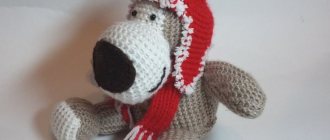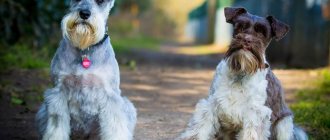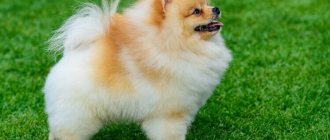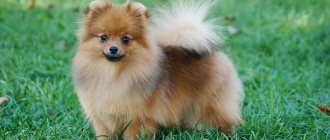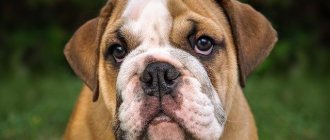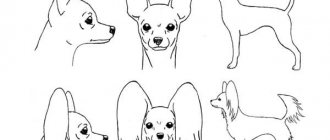History of the American Bully breed
Despite the recent origin of the breed, at that time the fame of its ancestors had not subsided for two centuries.
The reason for this is the relevance of bull-baiting, a bloodthirsty entertainment with the only possible outcome: a dog attacked a bull chained to the ground. This spectacle delighted casual onlookers and participants in the underground betting. Dogs obtained by crossing a terrier and an Old English bulldog were considered universal soldiers of the bloody arena. With the ban on bull baiting in 1835, fans of cruel games found a replacement in the form of dog pits. At the same time, through careful selection, new fighting breeds were developed - candidates for participation in baiting: the bull terrier and the Staffordshire bull terrier. The latter, having migrated to the USA, acquired a new name - American pit bull terriers.
Thoughts about creating a breed (according to another version, improving the character of an existing one) have visited breeders since the 1980s, but breeding work began a decade later. Her goal was to create a companion dog that would retain its intimidating appearance, but would acquire an easygoing and friendly character. The task seemed impossible given the “material”, because the controlled matings involved not decorative breeds, but ferocious four-legged fighters. Aggression is so firmly rooted in the character of baiting dogs that breeders had to spend many years to completely eradicate it.
Documentation on breeding work on American bullies does not contain reliable information, so the potential progenitors of the breed include not only pit bull terriers and Staffordshire terriers, but also bulldogs - French, English and even American. Many kennel founders (notably Razor's Edge owner Dave Wilson) have denied the inbreeding of more than two breeds, but the fact remains that the American Bully genotype has incorporated traits from at least five breeds.
The history of the origin of the breed is notable for the fact that breeding work was carried out by more than one dog breeder or club. Hundreds of American specialists worked on the creation of improved animals. They mainly lived in the states of Southern California and Virginia, but soon the fashion for dogs spread throughout the country. The future breed was given a name - bully, which translated from English means “hooligan, bully.”
Since American Bully breeders did not share the results of breeding work and did not unite in groups for further selection of dogs, the exterior of the animals varied significantly. Among the first bullies there were large and smaller individuals that had different proportions, structure and body type. The color palette included more than a dozen options. However, the similarity of the dogs with their distant ancestors still caused confusion and hindered the further development of the breed. This was the impetus for the creation of tribal organizations and clubs. Among them are the American Bully Kennel Club (ABKC), the United Bully Kennel Club (UBKC), the Bully Breed Kennel Club (BBKC), the United Canine Association (UCA), and the United Kennel Club (UKC). Europe was no exception: the European Bully Kennel Club (EBKC) was founded here. The latter's branches are located in Italy, Belgium, Germany, the Netherlands, Switzerland and France.
The appearance of a new breed caused a wave of indignation among lovers of Amstaffs and pit bulls. They considered the American Bully to be nothing more than an unceremonious interference in the breeding of classic fighting dogs. According to breeders, representatives of the new breed could not boast of either exterior or attractive working qualities. In addition, the dishonesty of individual breeders would lead to the appearance of mestizos - owners of a similar appearance, but weakened immunity and health.
The breed was recognized in 2004. The first canine organizations to include “Americans” in the official register were ABKC, UKC and EBKC. They also established the bully standard, which includes four varieties of dogs. Some small associations have even developed their own classification of the breed, based on the exterior and size.
At the international level, American bullies are still not recognized, although the number of dogs is growing every year. The bulk of fans of these giants are concentrated in the historical homeland of the breed - the USA. European countries do not have a rich selection of nurseries where bullies are bred; for example, in Russia there are no more than a dozen. Despite this, dogs are increasingly valued for their qualities as irreplaceable companions and their ability to flawlessly perform the tasks assigned to them.
Bully Scholarship Edition geography 1 lesson
The first lesson is very simple. On the topic we have European countries. Everything is nearby, everything is yours, dear, familiar. France, Germany, Spain, Italy. And even Ukraine, which is so close to both culture and heart. Drag a country's flag onto its outline on the map. Surely you haven't forgotten the flags? If so, keep your school atlas handy.
Lesson 1 – European countries
For an “excellent” rating after completing the test, you will receive as a reward the symbol of France - the Eiffel Tower. A baseball cap with her picture on it, to be more precise.
American Bully breed standard
The American Bully is a medium-sized breed. In the external appearance of the animals, there is a distant resemblance to their ancestors - pit bulls and amstaffs - with the exception of a more powerful and stocky physique. Despite the impressive mountain of muscles, the dogs are quite compact and agile, so they are able to give a head start to many representatives of fighting breeds - both in speed and endurance.
American Bullies are divided into four categories based on their height at the withers.
- Standard – the standard of the breed. It is considered the most numerous. The height of males varies between 43-51 cm, females - 40-48 cm.
- Classic – a lightweight version of the “standard” bullies. Differs in the most obvious similarities with pit bulls and Staffordshire terriers. The height of the animals at the withers is similar to the “standard” type: 43-51 cm (males) and 40-48 cm (females).
- Pocket, Pocket – the smallest of all “Americans”. The height of males reaches 36-43 cm, females - 33-40 cm. Otherwise, the appearance of the dogs fully corresponds to the breed standard.
- XL is a giant among American Bullies. Males grow up to 51-57 cm, females - 48-54 cm.
In addition to the main categories, there is also an unofficial classification of “Americans”. Bullies, which are shorter than the Pocket type, belong to the Micro variety. The largest dogs belong to the XXL category. Previously, the fifth type, “Extreme,” was also included among the types fixed by the standard. Over time, it was abolished at the initiative of the American Bully Kennel Club for demonstration purposes.
The body weight of dogs depends on their height at the withers, but in general varies from 30 to 58 kg.
Breed standards
Head and skull
The bully's head is square-shaped and of medium length; it seems massive and heavy, clearly defined. Never looks disproportionate to the dog's body. The wide skull is notable for its pronounced frontal part. Under the thick skin, relief muscles can be felt, the muscles in the cheek area are especially developed.
Muzzle
Wide and weighty; its shape is close to a square. The structure of the muzzle does not prevent the bully from breathing freely. Its length is less than the length of the skull, being no less than ¼ and no more than ⅓ of the total length of the head. Minor folds are acceptable. The transition from the forehead to the muzzle is deep and distinct, but not as much as in brachycephalic dog breeds. The bridge of the nose is wide and straight, “transforming” into a large lobe with developed nostrils. Pigmentation in any color is acceptable for her, except for reddish shades (indicative of albinism). The animal's lips fit tightly to the teeth; “sagging” in the area of the corners of the mouth is acceptable.
Ears
The ears are slightly pointed forward, as if the American Bully is always alarmed by something; have a high position. It is permissible to crop the ears to create one of four shapes: battle crop, short crop, show crop or long crop. Many dog owners refuse this procedure because “natural” ears are not considered a disqualifying defect.
Eyes
American Bullies have medium-sized eyes; set wide, deep and relatively low in relation to the animal's skull. Eye shape – almond or oval. The conjunctiva of the lower eyelids is almost invisible. Any color of the iris is acceptable, except blue and blue, if it is in harmony with the color of the bully.
Jaws and teeth
The American's strong jaws form a scissor bite. At the same time, the lower jaw is stronger and “frightening” in comparison with the upper; its conditional line is parallel to the muzzle. A complete dental formula is required.
Neck
Medium length, with distinct muscles; tapers from the back of the skull towards the back. A small “arch” is noticeable on the back of the neck. The skin is dense and elastic. Flabbiness is only acceptable for XL American Bullies.
Frame
The body looks massive, but at the same time compact. Square format. The distance from the dog's withers to the elbows and from the elbows to the paws is the same. The option when the second value is slightly less than the first is acceptable, but undesirable. The chest is formed by smoothly rounded ribs and does not protrude forward beyond the shoulders. It looks very wide due to the huge distance between the bully's forelimbs. The back is short and strong, and may be raised in relation to the croup. The latter is slightly inclined to the base of the tail. The loin is short and wide. The hemline is moderately tucked.
Tail
Mostly hook-shaped; A direct “analogue” is also acceptable. Set low, tapering from base to tip. When at rest, it is lowered to the level of the hock joints. When moving, it rises, continuing the topline. If the American Bully is excited or alarmed by something, the tail may “throw” over the back, but in no case curls into a ring.
Forelegs
Muscular and strong, slightly turned out towards the forearms. The humerus bones are laid back, connected to the wide and long shoulder blades at an angle of 35-45°. The elbows are pressed tightly to the chest, but a small gap is still acceptable. The pasterns are flexible and powerful, located at a slight angle to the surface. The paws are round and arched, proportional to the overall dimensions of the dog. Removal of dewclaws is desirable, but not necessary.
Hind limbs
Strong and wide, parallel and straight when viewed from behind. They are notable for their developed muscular system (the latter is especially noticeable in the area of the animal’s hips). Should appear in proportion to the forelegs. The hock joints are low and well arched. Deviations are allowed only for American Bullies of class XL. The lowered pasterns are perpendicular to the surface of the ground, turning into rounded paws. Dewclaws can be removed if desired, but their presence is not considered a disqualifying defect.
Movement style
American bullies move confidently and impressively, but at the same time they look as if they are expecting a sharp change in events every second. The gait is characterized by a strong push of the hind limbs. The trot is powerful, but at the same time light and well coordinated. The line of the back remains straight, let's say its smooth bend in time with the movements of the dog. The limbs extend neither out nor in; do not cross and do not get entangled. As speed increases, the legs move more and more closer to the center line.
Coat
The body of the American Bully is covered with short hair that is moderately hard to the touch. It fits tightly to the body; there is not the slightest hint of a receding hairline. In any light, the glossy shine of the hairs is noticeable. There is no undercoat.
Color
The breed standard is loyal to the color of the “Americans”. Any color combinations and point shapes are acceptable. The exception is the merle color.
Possible defects
Common defects in the American Bully breed include:
- light pink or reddish pigmentation of the nose;
- excessively short or long tail;
- pointed and/or long muzzle;
- underdeveloped lower jaw;
- wavy or curly coat;
- elongated coat;
- exposed third eyelid;
- weak and thin neck;
- clumsy movements;
- undershot or overshot;
- bulging eyes;
- turned out paws;
- creases on the tail;
- smoothed stop;
- straight bite;
- heterochromia;
- snub nose;
- amble.
Dogs are disqualified for the following reasons:
- bat-shaped ears (like those of a bat);
- unilateral or bilateral cryptorchidism;
- cowardly or aggressive behavior;
- marbled coat color;
- docked tail;
- curled tail;
- dwarfism;
- albinism;
- deafness.
American Bully character
Although American Bullies look like tough, tough guys, their appearance is nothing more than fertile ground for the emergence of frightening stereotypes. In fact, representatives of the breed are cheerful and balanced dogs that easily make contact and show genuine friendliness towards others. American bullies do not shy away from communication and affection; they will happily roll over on their back in front of you and close their eyes in anticipation of reverent strokes.
Animals are distinguished by an amazing ability to get along with all members of the “pack,” as they say, from young to old. Bullies are able to sense the “weather in the house” and defuse the tense atmosphere in a timely manner with a funny and clumsy prank. Representatives of the breed treat all family members kindly, but consider only one to be the owner. With him, dogs are incredibly gentle and strive at all costs to bring a happy smile on the face of their loved one. If you manage to find the key to the heart of a charming giant, be prepared for an obsessive (and sometimes manic) pursuit: American Bullies do not like to let their owner out of sight.
Due to their tendency to become attached to their family, these animals will not be able to spend most of their time alone. If spontaneous trips outside the city limits and the desire to put your thoughts in order in solitude are familiar to you, refuse to purchase an American Bully. These dogs need constant attention, but still they will not destroy furniture and continuously howl at a locked door in the short absence of the owner.
Please note: it is not recommended to often leave bullies in their own care. Over time, the animal will no longer see you as a leader whose words need to be listened to, and this is fraught with additional problems with the pet.
Despite their phlegmatic and good-natured disposition, “Americans” tend to dominate novice dog breeders. This is especially true for young male dogs who strive to defend their rights not only among their relatives, but also among people. Most often, bullies attempt to usurp power before the age of one and a half years. To avoid this, it is worth clearly defining the hierarchy from puppyhood, otherwise the intervention of a professional dog handler will be required. If you don't have experience keeping fighting dogs, look at other breeds. American Bullies are not suitable for older people or those with a gentle character.
The animals are known for their highly developed hunting instincts, which makes them quite good candidates for the role of guard dogs. Often American Bullies lack the aggressiveness to be considered ideal guard dogs. Bully owners laugh it off: this is not necessary, because the frightening appearance of the dogs is enough to scare away strangers from the protected area. If any of the family members is in danger, the “Americans” turn into a killing machine literally at the snap of their fingers. At this moment, the bully does not care about the size of the enemy: the animal will protect loved ones to the last.
Representatives of the breed are ideal as family dogs. Animals show amazing love towards children and bravely tolerate their antics. Curiosity, playfulness, desire for pranks and adventures are the main reasons why these big guys find a common language with little family members. American Bullies are capable of engaging in vigorous play for several hours without snarling or biting in response to painful jolts.
Important: It is extremely undesirable to leave a bully alone with a small child. The impressive dimensions of the animal are quite dangerous.
Well-socialized dogs get along well with other pets. An exception may be mature males who get involved in a fight for any reason - from territorial to sexual. This is especially noticeable during a walk, when the American Bully can show aggression towards its relatives. Cats, ornamental rodents and birds are not the best company for dogs. If possible, limit the American's contact with these pets.
Bullies cannot be called real “live”, but they are also not considered couch potatoes. Even an ordinary person can satisfy the breed's need for activity. A long walk (at least an hour and a half) twice a day is enough. Bully owners recommend occasionally going on a hike with their dogs: a new environment, active games and communication with the owner will give the pet a lot of positive emotions!
Bully Scholarship Edition
Has it ever happened to you that you suddenly feel nostalgic for your wonderful school years? Didn’t you want to return to your native Alma Mater, even for a short moment, to relive everything again, to refresh your knowledge in your memory? The Bully game is what you need. In it, you will turn into a cocky little boy, whose parents left him in the care of a private boarding school in the New England town of Bullworth, heading off on a year-long honeymoon. You will have to find your place in the sun according to the harsh laws that reign among school groups, and, of course, study diligently. And today we have a geography lesson on schedule. Proceed with your test, and we will discreetly prompt you.
In the game, this item can be called the most useful in terms of rewards, along with grammar. Demonstrate your keen intelligence in knowing the location of countries in Europe, Asia, North and South America, and Africa. And in one of the lessons you will even have to look at a map of the USA - you will need to figure out which state is where - this is a really difficult task. Especially if you're not much of a geographer. But don’t worry - as promised, today we will be your bosom friend, an excellent student who always helps out.
Education and training
Despite the high level of intelligence and desire to please its owner, the American Bully is not the easiest breed to handle. These dogs need socialization from the first day they arrive in their new home. It is important to teach your pet to calmly react to everything that may be new to him: sounds, smells, animals and people. At the same time, a trusting relationship between the owner and his ward is extremely important. You have to become both a loyal friend and an unconditional leader for the bully, otherwise communicating with the dog will cause a lot of trouble.
The intervention of an experienced dog handler in the case of an American Bully will not be superfluous. Representatives of the breed have a keen sense of the hierarchy of the “pack” and, at the first convenient opportunity, strive to take a dominant position. It is necessary to rein in the pet in time, thereby making it clear that the place of leader is not in dispute. The upbringing of an “American” should be moderately strict, without the use of physical force. If you act exactly the opposite, you can easily turn a bully into an angry and disobedient creature.
Dog owners describe the breed as quite difficult to train at home. Once in the hands of a beginner, the American Bully will eventually show obstinacy and disobedience. This rule especially applies to young males, who express a tendency toward dominance more strongly than females. For fruitful training, teams are recommended to use the services of an experienced trainer who has previously worked with fighting breeds. By observing the strategy of a professional, you yourself will understand how to handle American Bullies to avoid problems.
Please note: from the age of 6 months, you must enroll your pet in obedience courses. With ZKS (protective guard service) you will have to wait until the dog is two years old. Early training is fraught with mental problems for the American Bully.
Contrary to the common misconception that training without force is impossible, bullies need positive methods. At the same time, among the animals there are both gourmands, who are easily motivated by a “yummy”, and sissies, who cannot imagine training without affectionate stroking behind the ear. In the situation with the “Americans,” you cannot get by with the truisms of training. These dogs are motivated by the most unexpected things: from a walk in the park to the purchase of a new squeaky ball. You have to understand what pleases your pet the most - and then teaching commands will go like clockwork!
Health
Unfortunately, bullies are predisposed to diseases common to bulldogs.
Dysplasia , cardiovascular and ophthalmic diseases are quite common in this breed. Problems characteristic of brachycephals (shortened muzzle, which makes breathing difficult) may also appear. If you notice that your dog is breathing with wheezing, do not force him to run for a long time or do serious physical activity. In summer, when it’s hot, walk your dog early in the morning or late in the evening, when it’s still quite cool.
Ataxia is a pathological condition that occurs when there is damage to the cerebellum, a brain structure primarily responsible for the coordination of movements and orientation of the animal in space.
Care and maintenance
Caring for an American Bully is not much different from caring for another short-haired breed. To keep your dog looking neat, it is enough to brush his coat weekly using a coarse bristle brush or a furminator glove. Fine-toothed combs are ineffective. The seasonal shedding of the animal goes almost unnoticed, especially if you increase the frequency of combing to twice a week.
American Bullies do not require regular bathing. It is enough to wipe dogs with a damp towel or “sprinkle” them with dry shampoo to eliminate oily shine. If your pet gets dirty, use a hygiene product that does not contain alkalis or acids, and then rinse off the shampoo with warm running water. The bully's short "coat" dries out quite quickly, so it is not necessary to scare the dog with the loud buzzing of the hair dryer. You just have to allocate a secluded corner to the animal and make sure there are no drafts. Despite their strong immunity, American Bullies are susceptible to colds.
Remember: it is not recommended to bathe your bully more than once or twice a month! Otherwise, the coat will lose its protective fat layer, and the balanced functioning of the glands will be disrupted. This is fraught with the appearance of a specific odor, which is very difficult to get rid of.
Be sure to set aside time to examine your American's ears every day. Dog owners do not recommend wiping the ears for no apparent reason: there is a high risk of causing inflammation and accidentally causing an infection. Remove dirt and dust only as needed using a cotton swab soaked in drying lotion. It is better to avoid using cosmetic sticks: careless movement can injure soft tissues.
The eyes of the American Bully need regular examination, especially after a walk in windy weather. Foreign particles are removed with sweeping movements directed towards the inner corners. To do this, use a cotton pad and a special solution. As an alternative to the latter, you can take strong tea. If there is excessive souring, watery eyes or redness of the eyes, you should consult a specialist about treatment.
Maintaining cleanliness requires the bully's oral cavity, which, due to its anatomical structure, is prone to plaque formation. To completely remove it, two procedures per month are enough. Instead of “human” paste, use its analogue for animals (you can pamper your pet with a product with an unusual taste). Don't forget a toothbrush or finger brush. As a last resort, you can use a bandage wrapped tightly around your finger.
Preventative teeth cleaning is also important - using environmentally friendly rubber toys or treats made from compressed bones. They will slow down the formation of hard tartar, which can only be removed in a veterinary clinic.
Despite the high activity of American bullies, the natural grinding of claws on a hard surface is not enough for the pet’s comfort. Buy a nail clipper for large breeds - guillotine (for the American pocket type) or sickle-shaped (for bullies of the standard, classic and XL varieties). Regularly shorten your dog's manicure, remembering to smooth out any sharp edges with a nail file.
In the winter season, it is necessary to carefully examine the paw pads: salt sprinkled on ice can cause a chemical burn. Since the breed is distinguished by a high pain threshold, the pet will endure serious injuries without showing it.
One of the central roles in the full development of the American Bully is played by its nutrition. Dog owners claim that their pets can be fed with both high-quality industrial food (not lower than premium class) and natural products. It doesn’t matter which option you choose, because the main thing in feeding a bully is a balanced diet.
The advantage of ready-made food is the correctly formulated proportions of vitamins and microelements that are necessary for the dog’s excellent well-being. A diet of natural origin implies additional use of mineral supplements. Consult your veterinarian about the vitamins that are right for your dog. Amateur activity in this case is not encouraged.
The basis of a natural diet should be dietary meat, ideally boiled beef without salt and other spices. It is recommended to combine it with porridges: wheat, buckwheat or rice. Legumes are undesirable because they cause bloating. Consumption of fermented milk products (yogurt, low-fat cottage cheese, kefir) is permissible no more than 2-3 times a week, otherwise the animal will face problems with the gastrointestinal tract.
Don't forget to please your American Bully with seasonal vegetables and fruits: they are not only tasty, but also healthy. A tablespoon of vegetable oil added to food daily will improve the condition of your dog's skin and coat. Olive, corn, sunflower or flaxseed are suitable.
An American Bully puppy between 2 and 6 months of age is fed at least 5 times a day. In the period up to a year, the number of meals is reduced to 3-4. It is recommended to feed an adult dog over 12 months no more than 2 times a day. Moderate portions combined with physical activity will help avoid obesity.
The animal's diet should not include:
- boiled, canned or raw fish (sea fish is acceptable);
- fatty, salty, spicy and pickled foods;
- foods high in caffeine;
- bones of large animals, birds and fish;
- raisins, currants, grapes;
- raw and/or fatty meat;
- potatoes in any form;
- persimmons, peaches and plums;
- whole milk;
- onion and garlic;
- citrus;
- raw eggs;
- mushrooms.
The dog must have constant access to clean drinking water; ideally bottled, but it can also be replaced with flow-through water, after steeping for 6-8 hours.
American bullies are heat-loving creatures who like the comfort of city apartments or a private home. For keeping in an enclosure, it is better to opt for longer-haired breeds: German Shepherd, Scottish Collie, Bobtail or Alabai. Keeping a dog in “greenhouse” conditions involves physical activity - small but regular (at least 3 hours a day). To build and strengthen muscles, walking in special vests with weights is useful. Let your pet test his strength in more familiar “dog” sports: agility, fetching objects or weight-pulling.
American Bully Health and Diseases
Since the breed appeared relatively recently, American Bully breeders have not come to a common conclusion regarding the health of these powerful dogs. On average, bullies have strong immunity, but are susceptible to certain ailments. Among them:
- intolerance to hot weather;
- optic nerve atrophy;
- joint dysplasia;
- dental problems;
- demodicosis;
- cataract.
Since representatives of the breed are susceptible to heart pathologies, an annual veterinary examination is required. In addition, you should not neglect regular vaccination, as well as treatment against external and internal parasites. This will help your American Bully stay healthy for as long as possible.
How to choose a puppy
Buying an American Bully can be a test in the spirit of the Indiana Jones treasure hunter: in Russia there are only a few nurseries that specialize in breeding the breed. They are mainly concentrated in the vicinity of Moscow, St. Petersburg and other large cities.
Unscrupulous breeders often sell pit bulls and amstaffs under the guise of bullies: in puppyhood, these breeds really look alike. To avoid becoming a victim of deceivers, contact European and American breeders who have established themselves as conscientious specialists. If there is no opportunity to purchase a “foreign” bully, it is worth using the services of an expert dog handler who has dealt with fighting breeds of dogs and can easily distinguish them from each other.
However, do not be upset: the relatively small number of the breed indicates that specimens with good genetics are participating in the breeding program. First of all, decide on the type of American Bully: standard, classic, pocket or XL. Animals look the same when they are puppies, so if you are looking for a specific breed class, pay attention to older dogs (from six months and older).
The placement of puppies begins at 1.5-2 months, when they no longer need maternal care. Healthy babies show activity (sometimes excessive) and curiosity about the world around them, they look well-groomed and tidy. Does your favorite puppy cowardly tuck its tail between its legs and hide in a secluded corner? Avoid purchasing one: there is a high risk of acquiring a sick pet, with whom visits to the veterinary clinic will become a tradition.
Once you have chosen a dog, ask the breeder to provide a passport with initial vaccination records. It is recommended to first clarify the point regarding the living conditions of the animals. At first, it is advisable to recreate an atmosphere as close as possible to a kennel, so that your four-legged friend quickly adapts to life in a new family.
Bully Scholarship Edition geography lesson 2
Well, this is where things get more complicated. Today's lesson is about the United States of America. Everyone knows about them, but only a few know about their location. So this task is not for the weak. Same story - drag the state flag onto its picture. On the great and mighty Internet, find yourself a cheat sheet with a map of America in advance.
Lesson 2 – United States of America
You won’t be able to cope without it, just watch carefully so that the teacher doesn’t notice. If everything goes well, you will receive a racing suit as a gift.
American bully price
The cost of representatives of the breed is determined by the following factors:
- status and location of the nursery;
- compliance with the standard;
- pedigree;
- floor.
The price of American bullies in Russia starts from 150,000 rubles and often exceeds 400,000 rubles. Culled dogs are charged a lower price, but these animals cannot participate in the breeding program. Those from European nurseries are much cheaper: about 700 euros. However, the high price and rarity of the breed only fuel the interest of dog breeders: American Bullies are ideal friends and companions, without whom life no longer seems so fun and exciting!
Bully Scholarship Edition geography lesson 3
This time you will have to demonstrate deep knowledge regarding Asia. But here it’s already simpler, so there won’t be any special problems - Thailand, India, China, Japan - everything can be found quickly and without much thought.
Lesson 3 – Asian countries
For good studies, you will sign for a cute panda costume and a G&G card.
